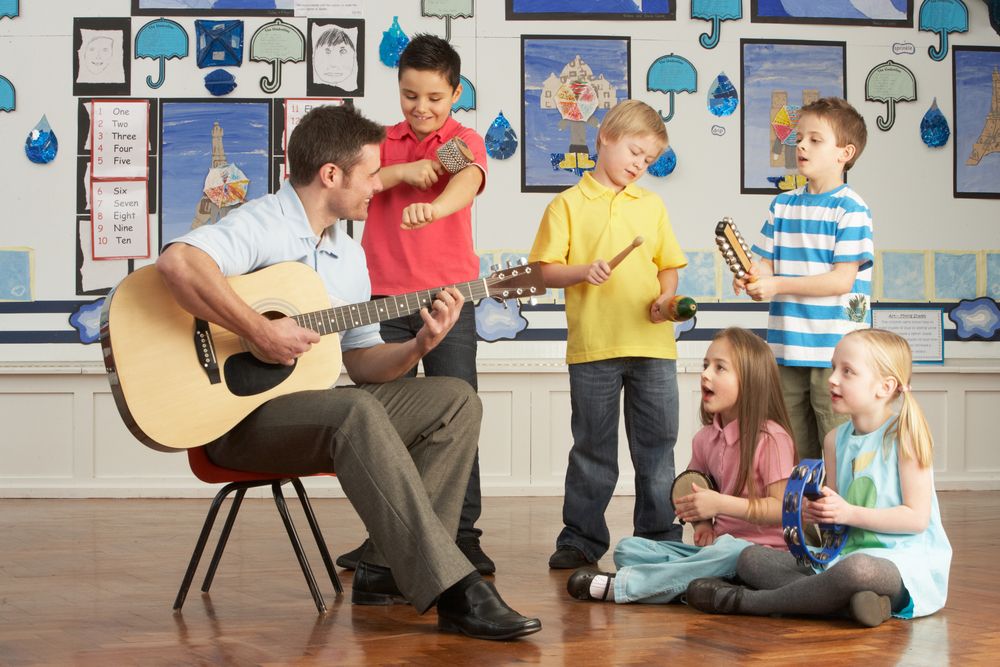3 Important Reasons to Weave Music into an Early Childhood Education Program
 From birth, we all seem to have a hint of toe tapping, head bobbing, and melody humming inclination in us. Music unites us in so many ways: culturally, socially, intellectually, physically and even academically. Parents use music to soothe a crying infant, teachers use lyrical tunes to teach children routines and lessons (who hasn’t learned their ABC’s by singing the alphabet song?!), and even adults use music to express emotions or just to make exercise a little more tolerable!
From birth, we all seem to have a hint of toe tapping, head bobbing, and melody humming inclination in us. Music unites us in so many ways: culturally, socially, intellectually, physically and even academically. Parents use music to soothe a crying infant, teachers use lyrical tunes to teach children routines and lessons (who hasn’t learned their ABC’s by singing the alphabet song?!), and even adults use music to express emotions or just to make exercise a little more tolerable!
And it’s not only limited to just the enjoyment of listening. Music has wide-ranging benefits, especially for young children. Fostering musical experiences in your program provides so many great opportunities to support your children’s development.
1. Builds Important Skills
A recent study found that musical experiences in childhood can actually accelerate brain development, particularly in the areas of language acquisition and reading skills. Music is also a key to overall childhood development, including social and emotional, intellectual, physical and academic skills.
According to the Children’s Music Workshop, the effect of music education on language development can be seen in the brain. “Recent studies have clearly indicated that musical training physically develops the part of the left side of the brain known to be involved with processing language, and can actually wire the brain’s circuits in specific ways. Linking familiar songs to new information can also help imprint information on young minds,” the group claims.
Research has also found that music can help children visualize various elements that should go together, like they would do when solving a math problem.
Musical education provides many positive benefits for young children, and you don’t have to wait until your child is in school — music education has even been shown to have positive effects on babies and toddlers!
2. Offers Music for the Ages
Infants - Infants recognize the melody of a song long before they are able to understand the words. Often they will try to mimic sounds and start moving to the music as much as they are physically able to do.
Quiet background music can be soothing for infants, especially at sleep time. Try to avoid loud music in the room as this may overstimulate an infant. Sing simple, short songs in a high, soft voice. Make up little ditties about bathing, dressing, or eating and sing to them while you are doing these activities.
Toddlers - Toddlers love to sing and dance and move to music. The key to music for toddlers is the repetition of songs, which encourages the use of words and memorization. They can also clap along to the music or “drum” on objects as appropriate.
Toddlers always enjoy laughing at silly songs. Use your creativity or sing a familiar song but instead insert a crazy word in the place of the correct word, like “the itsy, bitsy snail” instead of spider.
Preschoolers - Preschoolers love to sing and aren’t self-conscious about their abilities. Just ask a room full of preschoolers how many of them can sing and you’ll likely see every hand raised! They like songs that repeat words and melodies, have a rhythm they can follow, and encourage them to do fun and active movements.
Preschool children often enjoy nursery rhymes and songs about familiar things like toys, animals, play activities, and people. Try some songs with or without musical accompaniment.
School-Age Children - Most young school-age children are intrigued by kids’ singalong songs that involve counting, spelling, or remembering a sequence of events. This is often the age that children begin expressing their preferences for different types of music. They may express an interest in music education and learning to play a musical instrument.
3. Creates New Learning Opportunities
Music and singing can help children follow the routines at home and in their child care program. Clean-up songs let kids know it's time to put away their toys and end that activity. Use songs to move children from one activity to another, or to just keep them interested and occupied while they are waiting for the next activity.
Children will associate quiet music as a clear signal for nap time while loud, energetic music can get children up and moving or help them use up energy before they settle down to a quieter task.
Music also tends to help us remember things. Try using songs to help kids learn new ideas. The link to the video below has some great suggestions and easy-to-learn songs that teach children basic skills. You might even give this idea a try yourself next time you need to remember what items you want to pick up at the store!
Watch this video about Learning Songs
Infants (birth to age 1)
Recent research has found that babies benefit from music education long before they can even walk or talk. One study found that one-year-olds who participated in interactive music classes with their parents smiled more, communicated better, and showed more sophisticated brain responses to music.
The use of soft and colorful scarves or other soft manipulatives is a great way to introduce music and movement to infants. You can wave these in the air while singing soft lullabies and nursery rhymes. They are also great for sensory play, so be sure to let the infant feel the softness on their hands and feet. Be sure to note that movement props are not toys and are to be used only under adult supervision.
Toddlers (ages 1-3)
One of the biggest benefits of having toddlers engage with music is in language development. This development is specifically seen in parts of the left side of the brain, which contributes to processing language.
The key to musical engagement with toddlers is repetition. Children at this age need and  desire consistency and routine, which is why they love reading the same books and listening to the same songs over and over. Repeating songs together promotes memorization and helps them to predict what comes next.
desire consistency and routine, which is why they love reading the same books and listening to the same songs over and over. Repeating songs together promotes memorization and helps them to predict what comes next.
Toddlers also love being able to investigate and play with new objects, so encourage them to explore musical instruments. Those specifically designed for small hands and are easy to manipulate, such as percussion instruments that shake and rattle, are the perfect way to introduce young children to creating and playing music.
Preschoolers (ages 3-5)
Researchers in the field of brain development are quick to point out that the brain of a musician is wired differently than that of a non-musician, even a very young one. Preschoolers who were involved in making music showed larger brain growth in neural activity, so being a musician makes your brain work harder, even though it stills just seems like fun!
Preschoolers love to sing and aren’t shy about showing off their voices! They enjoy nursery rhymes about familiar things, and they like songs that have repeating words and melodies. Learning rhymes together and using puppets or other props is great fun for this age and great musical activities for preschoolers and their caregivers!
School-Aged Children (ages 5+)
A study published in 2007 at the University of Kansas reported that students in schools with superior music programs scored approximately 22 percent higher in English and 20 percent higher in math on standardized tests. This reveals how music impacts many aspects of a child’s life and how vital it is to school performance.
Elementary school may be the first time some children really begin to have an interest in taking music lessons for a specific instrument. Starting with simple musical instruments such as a recorder or basic percussion instruments is an easy way to introduce children to playing music.
Music is an important part of any child care curriculum. Young children love music and movement. Music activities and experiences help children practice important skills, including thinking, language, motor coordination and understanding emotions.
Watch video about Using Music to Help Children Learn
 Incorporating music into child care curriculum is a perfect way to blend child development and learning with fun activities that kids will enjoy! Listening to music, singing songs and playing instruments provides learning opportunities and make both children and child care providers feel good.
Incorporating music into child care curriculum is a perfect way to blend child development and learning with fun activities that kids will enjoy! Listening to music, singing songs and playing instruments provides learning opportunities and make both children and child care providers feel good.
Look for creative ways to include music in child care programs for ages to move and groove. Your kids will have so much fun they might not even realize they're learning! Most of all, just have fun and enjoy music for its own aesthetic qualities as well. And if you find yourself singing and dancing along with the kids, that's great, too!
For more information on how to use music in your child care program, try our online classes
Creative Learning Environments
“If you cannot teach me to fly, teach me to sing” – J.M. Barrie